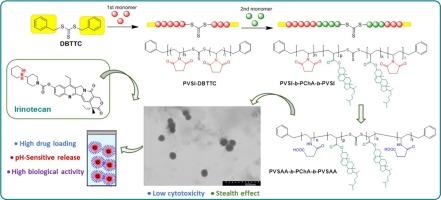RAFT-polymerization of N-vinyl succinimide mediated by S,S´-dibenzyl trithiocarbonate: Synthesis of homopolymers, block-copolymers and amphiphilic derivatives as drug delivery systems
IF 5.1
3区 工程技术
Q1 CHEMISTRY, APPLIED
引用次数: 0
Abstract
The development of novel polymers for biomedical applications remains a highly demanded field of polymer science. In this study, the radical polymerization of N-vinylsuccinimide (VSI) using S,S´-dibenzyl trithiocarbonate (DBTTC) as a reversible chain-transfer agent was investigated both in bulk and in 1,4-dioxane solution. The resulting polymers were characterized by SEC, 1H, 13С and HSQC NMR spectroscopy to determine their molecular weight distribution, conversion, and microstructure. The polymerization followed a controlled mechanism, as evidenced by linear molecular weight increase with conversion, suppression of the gel effect, and living chain behavior. The position of the trithiocarbonate group within the polymer chain was elucidated via nucleophilic and reduction reactions, and radical initiator substitution. The trithiocarbonate group was found to shift from a central to asymmetric position depending on synthesis conditions and chain length. PVSI-DBTTC was subsequently employed as a macro-RAFT agent for the synthesis of triblock copolymers with O-cholesteryl acrylate (ChA). These copolymers were analyzed by SEC, 1H NMR spectroscopy and DSC. Hydrolysis of the VSI units to N-vinylsuccinamic acid (VSAA) units yielded the amphiphilic triblock copolymer – PVSAA-b-PChA-b-PVSAA, which self-assembled into micelles in aqueous media. The resulting dispersions were characterized by dynamic light scattering (DLS) and transmission electron microscopy (TEM), which revealed the formation of spherical nanoparticles with a hydrodynamic diameter of up to 200 nm and a polydispersity index (PDI) below 0.3 in phosphate-buffered saline solution (pH 7.4). The developed micelles successfully encapsulated irinotecan and exhibited pH-responsive release. Furthermore, the nanoparticles demonstrated low cytotoxicity in various cells and low uptake by macrophages, as well as preserved the potent anticancer activity of the loaded drug, making them as promising candidate for effective drug delivery.

S,S′-三硫代碳酸二苄基介导的n -乙烯基琥珀酰亚胺的raft聚合:均聚物、嵌段共聚物和两亲性衍生物作为药物传递系统的合成
用于生物医学应用的新型聚合物的开发仍然是聚合物科学的一个高需求领域。本研究以S,S′-二苄基三硫代碳酸酯(DBTTC)为可逆链转移剂,研究了n-乙烯基琥珀酰亚胺(VSI)在散装和1,4-二恶烷溶液中的自由基聚合反应。通过SEC、1H、13С和HSQC核磁共振谱对所得聚合物进行了表征,确定了其分子量分布、转化率和微观结构。聚合反应遵循可控机理,分子量随转化率线性增加,凝胶效应和活链行为受到抑制。通过亲核反应、还原反应和自由基引发剂取代反应确定了三硫代碳酸盐基团在聚合物链中的位置。发现三硫代碳酸盐基团根据合成条件和链长从中心位置转移到不对称位置。PVSI-DBTTC随后被用作宏观raft剂,用于与o-丙烯酸胆固醇酯(ChA)合成三嵌段共聚物。用SEC、1H NMR和DSC对共聚物进行了分析。VSI单元水解为n -乙烯基琥珀酸(VSAA)单元,得到两亲性三嵌段共聚物- PVSAA-b-PChA-b-PVSAA,其在水介质中自组装成胶束。通过动态光散射(DLS)和透射电子显微镜(TEM)对所得到的分散体进行了表征,结果表明,在pH 7.4的磷酸盐缓冲盐水溶液中,所形成的球形纳米颗粒的水动力直径可达200 nm,多分散指数(PDI)小于0.3。所制备的胶束成功地封装了伊立替康,并表现出ph响应释放。此外,纳米颗粒在各种细胞中表现出低细胞毒性和低巨噬细胞摄取,并保留了负载药物的有效抗癌活性,使其成为有效药物递送的有希望的候选者。
本文章由计算机程序翻译,如有差异,请以英文原文为准。
求助全文
约1分钟内获得全文
求助全文
来源期刊

Reactive & Functional Polymers
工程技术-高分子科学
CiteScore
8.90
自引率
5.90%
发文量
259
审稿时长
27 days
期刊介绍:
Reactive & Functional Polymers provides a forum to disseminate original ideas, concepts and developments in the science and technology of polymers with functional groups, which impart specific chemical reactivity or physical, chemical, structural, biological, and pharmacological functionality. The scope covers organic polymers, acting for instance as reagents, catalysts, templates, ion-exchangers, selective sorbents, chelating or antimicrobial agents, drug carriers, sensors, membranes, and hydrogels. This also includes reactive cross-linkable prepolymers and high-performance thermosetting polymers, natural or degradable polymers, conducting polymers, and porous polymers.
Original research articles must contain thorough molecular and material characterization data on synthesis of the above polymers in combination with their applications. Applications include but are not limited to catalysis, water or effluent treatment, separations and recovery, electronics and information storage, energy conversion, encapsulation, or adhesion.
 求助内容:
求助内容: 应助结果提醒方式:
应助结果提醒方式:


